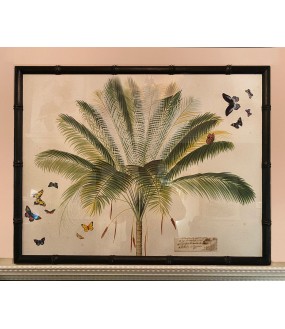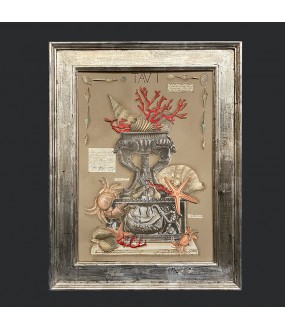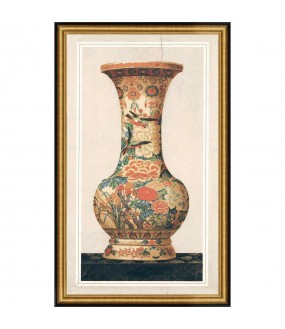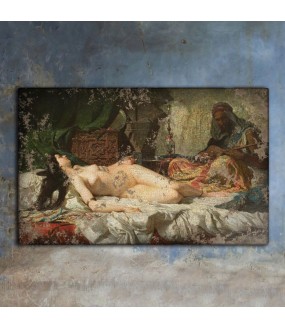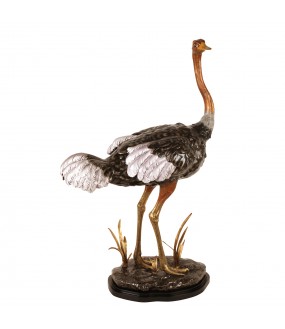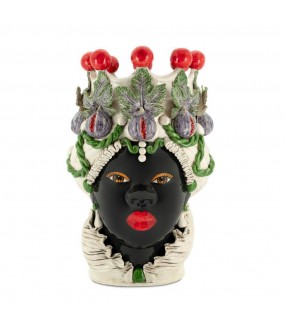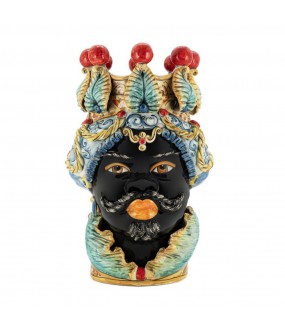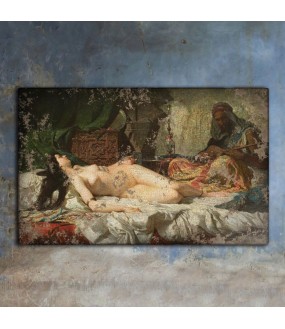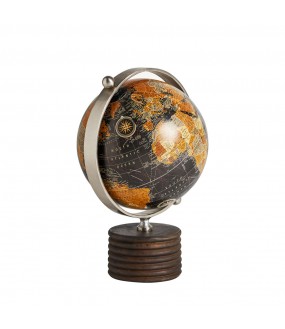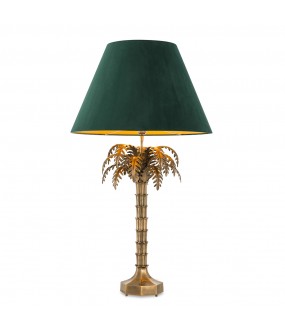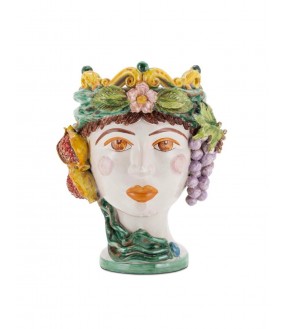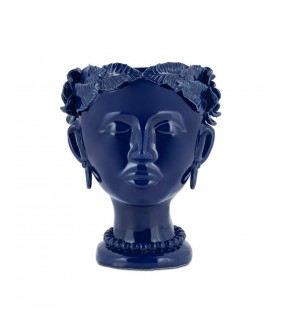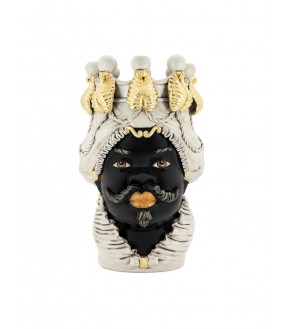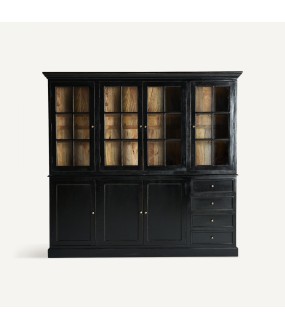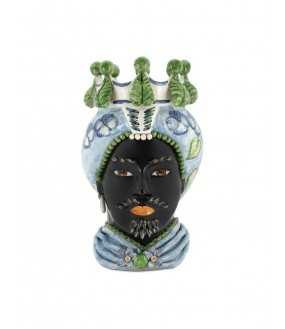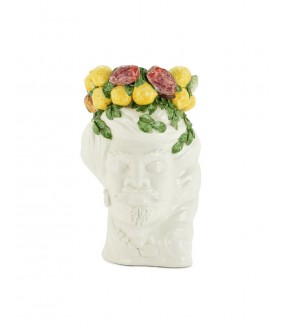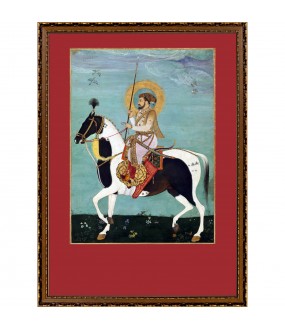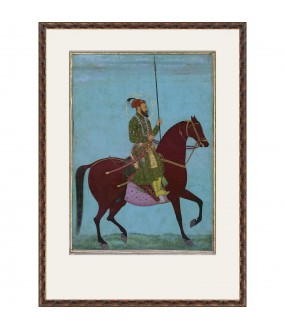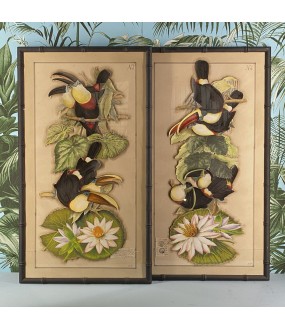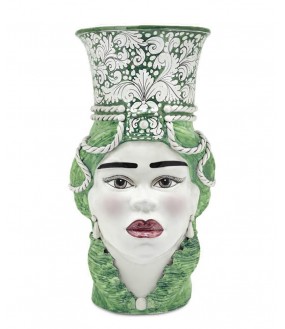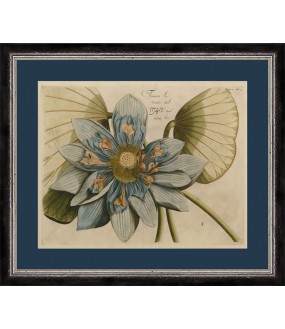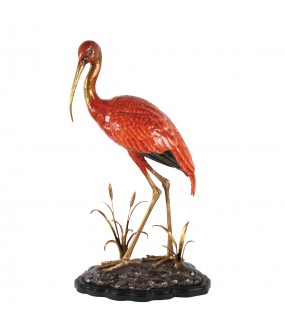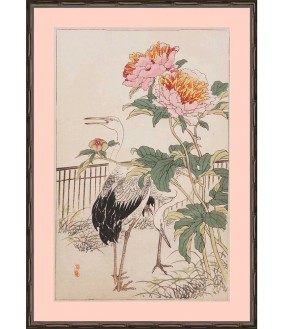Objects of Curiosities
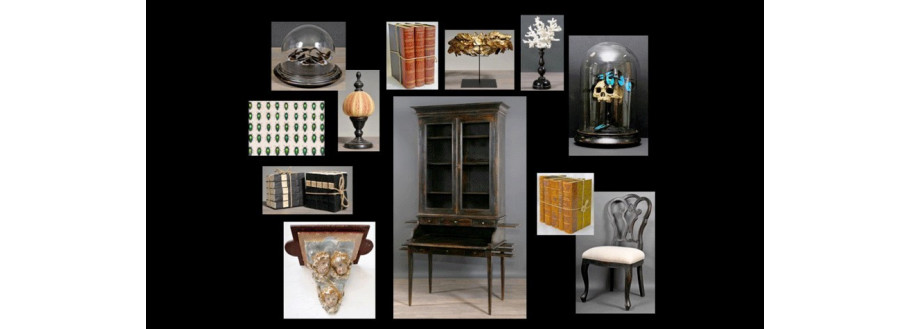
Find in this section objects of curiosities, unusual objects and unique pieces of Art & History and a selection of genuine and original antique furniture or current production drawing inspiration from the past.
To find more, please click here.
-
Hand-Printed Palm Prints, set of 2 - H121cm
€2,300.01Wonderful hand-printed palm prints. Framing and engravings entirely made and designed in Florence, Italy.
These exquisite engravings are engraved and printed on vintage presses from the 1800s. Each image is hand-printed, piece by piece.
Height: 121cm by 66cm in width.
A magnificent craftsmanship of remarkable finesse as only the artisans of Florence know how to do.
The handmade frame is made of tulip wood with a black patina.
A wonder, a dream and a pure escape.
Made exclusively to order. Deadline: 5 to 6 weeks.
-
Hand-Printed Palm Prints & Butterflies, set of...
€2,790.00Superb engravings of Palm trees with butterflies printed by hand. Framing and engravings entirely made and designed in Florence, Italy
These exquisite engravings are engraved and printed on vintage presses from the 1800s. Each image is then hand colored, piece by piece.
A magnificent craftsmanship of remarkable finesse as only the artisans of Florence know how to do.
The handmade frame is made of tulip wood patinated in black bamboo style.
A wonder, a dream and a pure escape.
Made exclusively to order. Deadline: 5 to 6 weeks.
-
Engravings Relics Shells and Corals, Set of 2
€2,760.00Two superb Relics made up of collages of prints and hand-painted seashells and corals. Watercolors made in Italy.
Wood frame in silver leaf. The sets are made by hand.
Framing and engravings entirely made and designed in Florence, Italy.
These exquisite engravings are engraved and printed on vintage presses from the 1800s. Each image is then hand colored, piece by piece.
A magnificent craftsmanship of remarkable finesse as only the artisans of Florence know how to do.
The handmade frame is made of tulip wood patinated in black bamboo style.
A wonder, a dream and a pure escape.
Made exclusively to order. Deadline: 5 to 6 weeks.
-
Empire Style Candle Holder in Brass,H54cm
€1,200.00Magnificent Empire Style CandleHolder in Brass. A very nice presence for this one-of-a-kind candlestick with a height of 54 cm.
-
Ancient Chinese Vases Engravings , Set of 2, H70cm
€650.01Set of 2 very beautiful reproductions of engravings of ancient Chinese vases. Each print is surrounded by an elegant distressed wood frame and clear glass.
-
Ceramic Vase, Coral Moor-Head Man - H50cm
€990.00Ceramic vase, head of a Moorish man, a traditional Sicilian achievement - Italy. This magnificent vase is produced and painted by hand in Caltagirone in Sicily and distributed exclusively by Arteslonga.
Handcrafted in ceramic, double firing. Entirely made and painted by hand in Caltagirone (Italy).
The Moors were members of the Muslim people of North Africa, of mixed Arab and Berber origin. In the 8th century they were converted to Islam and established power in North Africa, Sicily and Spain, where they established a civilization (756-1492).
THE LEGEND :
During the Arab domination in Sicily, in the city of Palermo there was an Arab suburb called "La Kalsa".
In this small suburb lived a beautiful young woman who spent her time tending to the flowers on her balcony.
One day a young Moor was walking under the lady's balcony. He noticed the beauty of the young lady and he fell in love with her.
He did not wait a minute to declare his love and the beautiful young girl, impressed by the audacity of the lover, quickly experienced the same love.
Unfortunately, the young Moor was already married and had several children ... as soon as the young woman found out that he could leave to find his family, one day she waited for night and killed him while he slept soundly. She cut off his head and used it as a vase for her plants so she could have him forever by her side.
As the beauty of this vase was remarkable, the whole neighborhood wanted to own a similar one.
From this moment, the creation of vases in the shape of the heads of Moors began...
-
Lying Woman Canvas H149x239cm
€3,240.00A very large and beautiful canvas straight out of the corridors of time. A Shabby chic reinterpretation of the odalisque by Maria Fortuny.
The original canvas was reproduced in the paint shop and then meticulously aged entirely by hand.
Every accident and lack, every crack or patina effect is never the result of chance... everything is brought together here so that this reinterpretation becomes more real than life.
Dimensions: H149x239x2cm
-
Lying Woman Canvas H113x161cm
€1,680.00A large and beautiful canvas straight out of the corridors of time. A Shabby chic reinterpretation of the odalisque by Maria Fortuny.
The original painting (56.9 cm × 81 cm) is on display at the National Art Museum of Catalonia in Barcelona.
The original canvas was reproduced in the paint shop and then meticulously aged entirely by hand.
Every accident and lack, every crack or patina effect is never the result of chance... everything is brought together here so that this reinterpretation becomes more real than life.
Dimensions: H113x161x2cm
-
Porcelain and Brass Ostrich H76cm
€2,280.00Superb ostrich figurine made of enamelled porcelain and brass with a total height of 76cm.
A current craft work of great beauty.
The legs of the bird and the plants are made of brass.
A remarkable piece for a refined and unique interior decoration.
-
Ceramic Vase, Woman Moor Head with Figs
€990.00Woman Moor Head Vase made in ceramic White and Blue, made in Sicily - Italy. Old ancient finishing, ceramic, double cooking entirely made and painted by hand in Caltagirone. The moors were members of Muslim people of North Africa, of mixed Arab and Berber descent.
-
Ceramic Vase, Man Moor Head Baroque
€700.00Vase of a Moor Head made in ceramic, Sicily - Italy. Borbon King, old ancient white finishing, ceramic, double cooking. The moors were members of Muslim people of North Africa, of mixed Arab and Berber descent. In the 8th century they were converted to Islam and established power in North Africa, Sicily and Spain, where they established a civilization (756–1492).
-
Ceramic Vase, Moor Man Head with Figs
€960.00Ceramic vase, male Moor's head with representation of figs, made entirely by hand in Sicily - Italy.
Handcrafted in ceramic, double firing and hand painted.
The Moors were members of the Muslim people of North Africa, of mixed Arab and Berber origin. In the 8th century they were converted to Islam and established power in North Africa, Sicily and Spain, where they established a civilization (756-1492).
THE LEGEND :
During the Arab domination in Sicily, in the city of Palermo there was an Arab suburb called "La Kalsa".
In this small suburb lived a beautiful young woman who spent her time tending to the flowers on her balcony.
One day a young Moor was walking under the lady's balcony. He noticed the beauty of the young lady and he fell in love with her.
He did not wait a minute to declare his love and the beautiful young girl, impressed by the audacity of the lover, quickly experienced the same love.
Unfortunately, the young Moor was already married and had several children ... as soon as the young woman found out that he could leave to find his family, one day she waited for night and killed him while he slept soundly. She cut off his head and used it as a vase for her plants so she could have him forever by her side.
As the beauty of this vase was remarkable, the whole neighborhood wanted to own a similar one.
From this moment, the creation of vases in the shape of the heads of Moors began...
-
Ceramic Vase, Moor Man Head with Lemons
€960.00Ceramic vase, male Moor's head with representation of beautiful yellow lemons, made entirely by hand in Sicily - Italy.
Handcrafted in ceramic, double firing and hand painted.
The Moors were members of the Muslim people of North Africa, of mixed Arab and Berber origin. In the 8th century they were converted to Islam and established power in North Africa, Sicily and Spain, where they established a civilization (756-1492).
THE LEGEND :
During the Arab domination in Sicily, in the city of Palermo there was an Arab suburb called "La Kalsa".
In this small suburb lived a beautiful young woman who spent her time tending to the flowers on her balcony.
One day a young Moor was walking under the lady's balcony. He noticed the beauty of the young lady and he fell in love with her.
He did not wait a minute to declare his love and the beautiful young girl, impressed by the audacity of the lover, quickly experienced the same love.
Unfortunately, the young Moor was already married and had several children ... as soon as the young woman found out that he could leave to find his family, one day she waited for night and killed him while he slept soundly. She cut off his head and used it as a vase for her plants so she could have him forever by her side.
As the beauty of this vase was remarkable, the whole neighborhood wanted to own a similar one.
From this moment, the creation of vases in the shape of the heads of Moors began...
-
Lying Woman Canvas, 3 Sizes Available
€3,420.00A large and beautiful canvas straight out of the corridors of time. A Shabby chic reinterpretation of the odalisque by Maria Fortuny.
The original painting (56.9 cm × 81 cm) is on display at the National Art Museum of Catalonia in Barcelona.
The original canvas was reproduced in the paint shop and then meticulously aged entirely by hand.
Every accident and lack, every crack or patina effect is never the result of chance... everything is brought together here so that this reinterpretation becomes more real than life.
Lying Woman Canvas H88x129cm
-
Earth Globe H42cm
€260.00A large earth globe in soft tones of pink and pale green. On a black wooden cross base. 12 inches globe.Black and bronze terrestrial globe in vintage style on its mango wood stand.
Size of the globe: 32 cm in diameter and total height 43cm.
The base is made of turned solid mango wood in coffee color.
Crazy elegance.
A craftsmanship full of finesse and delicacy.
-
Earth Globe H34cm
€180.00A large earth globe in soft tones of pink and pale green. On a black wooden cross base. 12 inches globe.Black and bronze terrestrial globe in vintage style on its mango wood stand.
Size of the globe: 21cm in diameter and total height 34cm.
The base is made of turned solid mango wood in coffee color.
Crazy elegance.
A craftsmanship full of finesse and delicacy.
-
Table Lamp Fauna H115cm
€1,280.00Very beautiful brass table lamp in the shape of a palm tree.
Bring tropical opulence to your interior with the Fauna Table Lamp. The base of the lamp has the shape of a palm tree and a vintage brass finish.
This botanical beauty comes complete with a conical green velvet shade.
This lamp is handcrafted in solid brass.
-
Ceramic Vase, Woman Moor Head, 8 Colors
€720.00Ceramic vase, head of a Moorish woman, Sicily - Italy.
Handcrafted in ceramic, double fired and hand painted in Italy.
The moors were members of Muslim people of North Africa, of mixed Arab and Berber descent. In the 8th century they were converted to Islam and established power in North Africa, Sicily and Spain, where they established a civilization (756–1492).
THE LEGEND :
During the Arab domination in Sicily, in Palermo city, there was an Arab Suburb called "La Kalsa".
In this small suburb was living a beautiful young lady who used to spend her time in taking care of the flowers on her balcony.
One day, a young moor was walking down the lady's balcony. He noticed the beauty of the lady and he truly fell in love with her.
He did not wait a minute to declare his love for her, and the beautiful young lady, impressed by the lover's boldness, started feeling the same love.
Unfortunately, the young moor was already married and was father of a few kids... as soon as the young lady found out that he would have left for going back to his family, she waited until the night and killed him while he was sleeping deeply. She cut his head and used it as a vase for her plants, so that she could have him forever by her side.
As the beauty of this vase was magnificent, all the neighborhood wanted to own a similar one.
From that moment, they decide to create ceramics moor heads as vases.
-
Ceramic Vase, Woman Moor Head, Mix Colors
€690.00Ceramic vase, head of a Moorish woman, Sicily - Italy.
Handcrafted in ceramic, double fired and hand painted in Italy.
The moors were members of Muslim people of North Africa, of mixed Arab and Berber descent. In the 8th century they were converted to Islam and established power in North Africa, Sicily and Spain, where they established a civilization (756–1492).
THE LEGEND :
During the Arab domination in Sicily, in Palermo city, there was an Arab Suburb called "La Kalsa".
In this small suburb was living a beautiful young lady who used to spend her time in taking care of the flowers on her balcony.
One day, a young moor was walking down the lady's balcony. He noticed the beauty of the lady and he truly fell in love with her.
He did not wait a minute to declare his love for her, and the beautiful young lady, impressed by the lover's boldness, started feeling the same love.
Unfortunately, the young moor was already married and was father of a few kids... as soon as the young lady found out that he would have left for going back to his family, she waited until the night and killed him while he was sleeping deeply. She cut his head and used it as a vase for her plants, so that she could have him forever by her side.
As the beauty of this vase was magnificent, all the neighborhood wanted to own a similar one.
From that moment, they decide to create ceramics moor heads as vases.
-
Ceramic Vase, Woman Moor Head
€800.00Ceramic vase, head of a Moorish woman, Sicily - Italy.
Handcrafted in ceramic, double fired and hand painted in Italy.
The moors were members of Muslim people of North Africa, of mixed Arab and Berber descent. In the 8th century they were converted to Islam and established power in North Africa, Sicily and Spain, where they established a civilization (756–1492).
THE LEGEND :
During the Arab domination in Sicily, in Palermo city, there was an Arab Suburb called "La Kalsa".
In this small suburb was living a beautiful young lady who used to spend her time in taking care of the flowers on her balcony.
One day, a young moor was walking down the lady's balcony. He noticed the beauty of the lady and he truly fell in love with her.
He did not wait a minute to declare his love for her, and the beautiful young lady, impressed by the lover's boldness, started feeling the same love.
Unfortunately, the young moor was already married and was father of a few kids... as soon as the young lady found out that he would have left for going back to his family, she waited until the night and killed him while he was sleeping deeply. She cut his head and used it as a vase for her plants, so that she could have him forever by her side.
As the beauty of this vase was magnificent, all the neighborhood wanted to own a similar one.
From that moment, they decide to create ceramics moor heads as vases.
-
Ceramic Vase, Paladin Woman Moor Head
€780.00Ceramic vase, head of a Paladin Moorish woman, Sicily - Italy.
The paladin is a knight who has reached one of the highest ranks, is part of a religious order and bears the sacred power of faith.
Handcrafted in ceramic, double fired and hand painted in Italy.
The moors were members of Muslim people of North Africa, of mixed Arab and Berber descent. In the 8th century they were converted to Islam and established power in North Africa, Sicily and Spain, where they established a civilization (756–1492).
THE LEGEND :
During the Arab domination in Sicily, in Palermo city, there was an Arab Suburb called "La Kalsa".
In this small suburb was living a beautiful young lady who used to spend her time in taking care of the flowers on her balcony.
One day, a young moor was walking down the lady's balcony. He noticed the beauty of the lady and he truly fell in love with her.
He did not wait a minute to declare his love for her, and the beautiful young lady, impressed by the lover's boldness, started feeling the same love.
Unfortunately, the young moor was already married and was father of a few kids... as soon as the young lady found out that he would have left for going back to his family, she waited until the night and killed him while he was sleeping deeply. She cut his head and used it as a vase for her plants, so that she could have him forever by her side.
As the beauty of this vase was magnificent, all the neighborhood wanted to own a similar one.
From that moment, they decide to create ceramics moor heads as vases.
-
Table Lamp Empire
€740.00Very beautiful table lamp in black lacquered wood and its beautiful printed cotton lampshade with fringes.
Bring tropical, animalistic opulence to your interior with the Empire table lamp. The base of the lamp is in black glass.
The cotton velvet lampshade brings botanical and animal style and beauty.
This lamp is handcrafted in Italy.
Available in two lampshade versions: black or white background.
-
Ceramic Vase, Woman Moor Head
€800.00Ceramic vase, head of a Moorish woman, Sicily - Italy.
Head-shaped vase, Italian-made to the smallest detail, all decorations are applied and hand painted making each piece unique.
Handcrafted in ceramic, double fired and hand painted in Italy.
The moors were members of Muslim people of North Africa, of mixed Arab and Berber descent. In the 8th century they were converted to Islam and established power in North Africa, Sicily and Spain, where they established a civilization (756–1492).
THE LEGEND :
During the Arab domination in Sicily, in Palermo city, there was an Arab Suburb called "La Kalsa".
In this small suburb was living a beautiful young lady who used to spend her time in taking care of the flowers on her balcony.
One day, a young moor was walking down the lady's balcony. He noticed the beauty of the lady and he truly fell in love with her.
He did not wait a minute to declare his love for her, and the beautiful young lady, impressed by the lover's boldness, started feeling the same love.
Unfortunately, the young moor was already married and was father of a few kids... as soon as the young lady found out that he would have left for going back to his family, she waited until the night and killed him while he was sleeping deeply. She cut his head and used it as a vase for her plants, so that she could have him forever by her side.
As the beauty of this vase was magnificent, all the neighborhood wanted to own a similar one.
From that moment, they decide to create ceramics moor heads as vases.
-
Ceramic Vase, Moor Head Man - H48cm
€990.00Ceramic vase, head of a Moorish man, a traditional Sicilian achievement - Italy. This magnificent vase is produced and painted by hand in Caltagirone in Sicily and distributed exclusively by Arteslonga.
Handcrafted in ceramic, double firing. Entirely made and painted by hand in Caltagirone (Italy).
The Moors were members of the Muslim people of North Africa, of mixed Arab and Berber origin. In the 8th century they were converted to Islam and established power in North Africa, Sicily and Spain, where they established a civilization (756-1492).
THE LEGEND :
During the Arab domination in Sicily, in the city of Palermo there was an Arab suburb called "La Kalsa".
In this small suburb lived a beautiful young woman who spent her time tending to the flowers on her balcony.
One day a young Moor was walking under the lady's balcony. He noticed the beauty of the young lady and he fell in love with her.
He did not wait a minute to declare his love and the beautiful young girl, impressed by the audacity of the lover, quickly experienced the same love.
Unfortunately, the young Moor was already married and had several children ... as soon as the young woman found out that he could leave to find his family, one day she waited for night and killed him while he slept soundly. She cut off his head and used it as a vase for her plants so she could have him forever by her side.
As the beauty of this vase was remarkable, the whole neighborhood wanted to own a similar one.
From this moment, the creation of vases in the shape of the heads of Moors began...
-
Library Edgard XIXth Style, Double Body
€5,280.00The large Edgard library consists of a double body and has the particularity of having an apothecary style from the beginning of the 19th century.
This large bookcase, made entirely of solid mango wood, is made up of 2 independent modules, top (dresser cabinet) and bottom (sideboard), which will dress your interior in a majestic way.
The two upper and lower parts can be offered for sale separately.
The aged black patina and its solid old mango wood interior give it an old look as if it had come out of a natural history museum.
The complete piece of furniture (upper and lower part) measures 430cm high by 218cm wide by 42cm deep. Total weight 170kg.
Dimensions of the upper glazed part which consists of 4 doors and 4 shelves:
Length: 218cm - Depth: 42cm - Height: 113cm
Dimensions of the lower part which consists of a single block of 4 doors and 4 drawers:
Length: 212cm - Depth: 40cm - Height: 92cm
This large bookcase will also go very well with an industrial style.
Delivery on the ground floor only.
For upstairs delivery, please contact us.
-
Ceramic Vase, Man Moor Blue and Lilac
€900.00Man Moor Head Vase made in ceramic Lilac and Blue, made in Sicily - Italy. Old ancient finishing, ceramic, double cooking entirely made and painted by hand in Caltagirone. The moors were members of Muslim people of North Africa, of mixed Arab and Berber descent.
-
Ceramic Vase, Moor Head Man - H48cm
€990.00Ceramic vase, head of a Moorish man, a traditional Sicilian achievement - Italy. This magnificent vase is produced and painted by hand in Caltagirone in Sicily and distributed exclusively by Arteslonga.
Handcrafted in ceramic, double firing. Entirely made and painted by hand in Caltagirone (Italy).
The Moors were members of the Muslim people of North Africa, of mixed Arab and Berber origin. In the 8th century they were converted to Islam and established power in North Africa, Sicily and Spain, where they established a civilization (756-1492).
THE LEGEND :
During the Arab domination in Sicily, in the city of Palermo there was an Arab suburb called "La Kalsa".
In this small suburb lived a beautiful young woman who spent her time tending to the flowers on her balcony.
One day a young Moor was walking under the lady's balcony. He noticed the beauty of the young lady and he fell in love with her.
He did not wait a minute to declare his love and the beautiful young girl, impressed by the audacity of the lover, quickly experienced the same love.
Unfortunately, the young Moor was already married and had several children ... as soon as the young woman found out that he could leave to find his family, one day she waited for night and killed him while he slept soundly. She cut off his head and used it as a vase for her plants so she could have him forever by her side.
As the beauty of this vase was remarkable, the whole neighborhood wanted to own a similar one.
From this moment, the creation of vases in the shape of the heads of Moors began...
-
Ceramic Vase, Moor Man Head with Lemons
€670.01Ceramic vase, male Moor's head with representation of beautiful yellow lemons, made entirely by hand in Sicily - Italy.
Handcrafted in ceramic, double firing and hand painted.
The Moors were members of the Muslim people of North Africa, of mixed Arab and Berber origin. In the 8th century they were converted to Islam and established power in North Africa, Sicily and Spain, where they established a civilization (756-1492).
THE LEGEND :
During the Arab domination in Sicily, in the city of Palermo there was an Arab suburb called "La Kalsa".
In this small suburb lived a beautiful young woman who spent her time tending to the flowers on her balcony.
One day a young Moor was walking under the lady's balcony. He noticed the beauty of the young lady and he fell in love with her.
He did not wait a minute to declare his love and the beautiful young girl, impressed by the audacity of the lover, quickly experienced the same love.
Unfortunately, the young Moor was already married and had several children ... as soon as the young woman found out that he could leave to find his family, one day she waited for night and killed him while he slept soundly. She cut off his head and used it as a vase for her plants so she could have him forever by her side.
As the beauty of this vase was remarkable, the whole neighborhood wanted to own a similar one.
From this moment, the creation of vases in the shape of the heads of Moors began...
-
Ceramic Vase, Woman Moor Head
€800.01Ceramic vase, head of a Moorish woman, Sicily - Italy.
Handcrafted in ceramic, double fired and hand painted in Italy.
The moors were members of Muslim people of North Africa, of mixed Arab and Berber descent. In the 8th century they were converted to Islam and established power in North Africa, Sicily and Spain, where they established a civilization (756–1492).
THE LEGEND :
During the Arab domination in Sicily, in Palermo city, there was an Arab Suburb called "La Kalsa".
In this small suburb was living a beautiful young lady who used to spend her time in taking care of the flowers on her balcony.
One day, a young moor was walking down the lady's balcony. He noticed the beauty of the lady and he truly fell in love with her.
He did not wait a minute to declare his love for her, and the beautiful young lady, impressed by the lover's boldness, started feeling the same love.
Unfortunately, the young moor was already married and was father of a few kids... as soon as the young lady found out that he would have left for going back to his family, she waited until the night and killed him while he was sleeping deeply. She cut his head and used it as a vase for her plants, so that she could have him forever by her side.
As the beauty of this vase was magnificent, all the neighborhood wanted to own a similar one.
From that moment, they decide to create ceramics moor heads as vases.
-
Alexeï Library XIXth Style - Separate Columns
€3,260.00The Alexeï library has the particularity of having an "industrial" apothecary style from the beginning of the 19th century. The exterior patina is aged black, old wood interior finish.
1 - The glass column is made up of a lower part with 2 sliding glass doors and 10 open storage lockers
2 - The column with drawers is composed in the lower part of 6 drawers, 2 high sliding glass doors in front of 6 storage lockers, 4 open storage lockers.
If you assemble 2 glass columns with a central column with drawers you can create a large and beautiful bookcase Bookcase 300cm long by 240cm high which will dress your wall in a majestic and playful way.
The aged black patina and its old wood interior give it an old appearance as if it came from a natural history museum.
This large bookcase will also go very well with an industrial style.
Delivery to the ground floor exclusively or upon request for a quote.
-
Engraving of Shah Jahan on Horseback 50x70cm
€360.00Magnificent engraving of Shah Jahan parading on horseback.
Beautiful warm and deep colors, aged carved wood frame.
Dimensions of the glass pane: 50x70cm.
Mirza Shahab-ud-Din Baig Muhammad Khan Khurram (5 January 1592 – 22 January 1666), also known as Shah Jahan I, literally 'King of the World', was the fifth Mongol emperor, reigning from 1628 to 1658. Under his reign, the Mongols reached the height of their architectural achievements and cultural glory.
Third son of Jahangir (r. 1605-1627), Shah Jahan participated in military campaigns against the Rajputs of Mewar and the Lodis of the Deccan. After Jahangir's death in October 1627, Shah Jahan defeated his youngest brother Shahryar Mirza and crowned himself emperor in Agra Fort. In addition to Shahryar, Shah Jahan executed most of his rival claimants to the throne. He commissioned many monuments, including the Red Fort, the Shah Jahan Mosque and the Taj Mahal, where his favorite wife, Mumtaz Mahal, is buried. In foreign affairs, Shah Jahan presided over aggressive campaigns against the Deccan sultanates, conflicts with the Portuguese, and wars with the Safavids. He also put down several local rebellions and faced the devastating Deccan famine of 1630–32.
In September 1657, Shah Jahan fell ill and appointed his eldest son Dara Shikoh as his successor. This appointment led to a succession crisis among his three sons, of which Shah Jahan's third son, Aurangzeb (r. 1658–1707), emerged victorious and became the sixth emperor, executing all of his surviving brothers, including the Crown Prince Dara Shikoh. After Shah Jahan recovered from his illness in July 1658, Aurangzeb imprisoned his father at Agra Fort from July 1658 until his death in January 1666.[6] He was buried next to his wife in the Taj Mahal. His reign is known for putting an end to the liberal policies initiated by Akbar.
During Shah Jahan's era, Islamic revival movements like the Naqshbandi began to shape Mongolian politics.
-
Engraving of Aurangzeb 50x70cm
€360.00Magnificent engraving of Aurangzeb parading on horseback.
Beautiful warm and deep colors, aged carved wood frame.
Dimensions of the glass pane: 50x70cm.
Muhi al-Din Muhammad (c. 1618 – March 3, 1707), commonly known as Aurangzeb lit. 'Ornament of the throne' and by his royal name Alamgir I, lit. 'Conqueror of the world', was the sixth Mughal emperor, reigning from 1658 until his death in 1707.
Under his reign, the Mongol empire reached its peak with a territory covering almost the entire Indian subcontinent.
Widely considered the last effective Mongol ruler, Aurangzeb compiled the Fatawa 'Alamgiri and was among the few monarchs to fully establish Sharia law and Islamic economics throughout the Indian subcontinent.
Aurangzeb belonged to the aristocratic Timurid dynasty, held administrative and military positions under his father Shah Jahan (r. 1628–1658), and was recognized as an accomplished military commander. Aurangzeb was viceroy of Deccan in 1636-1637 and governor of Gujarat in 1645-1647. He jointly administered the provinces of Multan and Sindh in 1648-1652 and continued his expeditions into neighboring Safavid territories. In September 1657, Shah Jahan appointed his eldest and liberal son Dara Shikoh as his successor, a decision repudiated by Aurangzeb, who proclaimed himself emperor in February 1658. In April 1658, Aurangzeb defeated Shikoh's allied army and the kingdom of Marwar at victory. Aurangzeb's decisive victory at the Battle of Samugarh in May 1658 cemented his sovereignty and his suzerainty was recognized throughout the Empire. After Shah Jahan recovered from his illness in July 1658, Aurangzeb declared him incompetent to rule and imprisoned his father in Agra Fort.
-
Antique Parrots Engravings, Set of 2
€864.00A set of two beautiful reproductions of engravings of magnificent flamboyantly colored parrots whose species have unfortunately disappeared.
Engravings with powder pink marie-louis and very beautiful black wood ornamentation frame.
Glass size: 50x70cm
-
Toucans Engravings Made by Collages
€2,990.00A pair of magnificent Toucans engravings made from collages of old juxtaposed engravings which are previously hand painted.
A magnificent artisanal work of remarkable finesse executed in Italy according to an ancestral process.
Within each frame an atmosphere is created by a juxtaposition of exquisite hand engravings which are engraved and printed on vintage presses from the 1800s.
Each image is printed in black and white, individually hand colored with gouache and in watercolor then cut out.
Superb and one of a kind.
-
Ceramic Vase, Green Woman Moor Head
€900.00Ceramic vase, head of a Moorish woman, Sicily - Italy.
Handcrafted in ceramic, double fired and hand painted in Italy.
The moors were members of Muslim people of North Africa, of mixed Arab and Berber descent. In the 8th century they were converted to Islam and established power in North Africa, Sicily and Spain, where they established a civilization (756–1492).
THE LEGEND :
During the Arab domination in Sicily, in Palermo city, there was an Arab Suburb called "La Kalsa".
In this small suburb was living a beautiful young lady who used to spend her time in taking care of the flowers on her balcony.
One day, a young moor was walking down the lady's balcony. He noticed the beauty of the lady and he truly fell in love with her.
He did not wait a minute to declare his love for her, and the beautiful young lady, impressed by the lover's boldness, started feeling the same love.
Unfortunately, the young moor was already married and was father of a few kids... as soon as the young lady found out that he would have left for going back to his family, she waited until the night and killed him while he was sleeping deeply. She cut his head and used it as a vase for her plants, so that she could have him forever by her side.
As the beauty of this vase was magnificent, all the neighborhood wanted to own a similar one.
From that moment, they decide to create ceramics moor heads as vases.
-
Giant Ceramic Vase Woman Moor Head
€2,500.00Magnificent traditional ceramic vase in the shape of a Moorish woman's head in green or malachite color - Italy. An extreme delicacy.
Handcrafted in ceramic, double fired. Completely made and painted by hand by the original artisan producer from Caltagirone - Sicily.
Distributed exclusively by Arteslonga.
The Moors were members of the Muslim people of North Africa, of mixed Arab and Berber origin. In the 8th century, they converted to Islam and established power in North Africa, Sicily and Spain, where they established a civilization (756-1492).
THE LEGEND :
During the Arab rule in Sicily, in the city of Palermo there was an Arab suburb called "La Kalsa".
In this small suburb there lived a beautiful young woman who spent her time taking care of the flowers on her balcony.
One day, a young Moor was walking under the lady's balcony. He noticed the beauty of the young lady and he fell in love with her.
He did not wait a minute to declare his love and the beautiful young girl, impressed by the lover's audacity, quickly felt the same love.
Unfortunately, the young Moor was already married and was the father of several children... as soon as the young woman discovered that he might leave to find his family one day, she waited until nightfall and killed him while he was sound asleep. She cut off his head and used it as a vase for her plants so that she could have him by her side forever.
As the beauty of this vase was remarkable, the whole neighborhood wanted to own one like it.
From this moment, the creation of vases in the shape of Moorish heads began...
-
Moor Ceramic Vase, Matt Mud Color
€1,200.00Ceramic vase, male Moor's head with representation of beautiful yellow lemons, made entirely by hand in Sicily - Italy.
Handcrafted in ceramic, double firing and hand painted.
The Moors were members of the Muslim people of North Africa, of mixed Arab and Berber origin. In the 8th century they were converted to Islam and established power in North Africa, Sicily and Spain, where they established a civilization (756-1492).
THE LEGEND :
During the Arab domination in Sicily, in the city of Palermo there was an Arab suburb called "La Kalsa".
In this small suburb lived a beautiful young woman who spent her time tending to the flowers on her balcony.
One day a young Moor was walking under the lady's balcony. He noticed the beauty of the young lady and he fell in love with her.
He did not wait a minute to declare his love and the beautiful young girl, impressed by the audacity of the lover, quickly experienced the same love.
Unfortunately, the young Moor was already married and had several children ... as soon as the young woman found out that he could leave to find his family, one day she waited for night and killed him while he slept soundly. She cut off his head and used it as a vase for her plants so she could have him forever by her side.
As the beauty of this vase was remarkable, the whole neighborhood wanted to own a similar one.
From this moment, the creation of vases in the shape of the heads of Moors began...
-
Blue Lotus Engravings, Set of 2
€680.00A set of two beautiful prints of magnificent large blue lotuses.
Engravings with blue marie-louis and very beautiful frame with black wood ornamentation and silver edging.
Glass size: 50x70cm
The lotus is an aquatic plant whose flower is magnificent and which is magnified in these two large engravings in a beautiful blue color. This particular tone of blue has earned it the name of a shade, azure tending to sky blue: caeruleum blue (ceruleum).
The blue lotus is actually a water lily.
Although it bears the name Lotus, the Blue Lotus (in Latin Nymphaea caerulea Savigny) is actually a water lily.
This aquatic plant grows on the edges of lakes and stagnant waters.
Today, it has almost completely disappeared from the Nile region and it is cultivated mainly in Asia (China and Thailand).
The blue lotus belongs to the family Nymphaeaceae (water lily family), group Apocarpiae, subgenus Brachyceras, and forms and subspecies None (cf. Slocum et al. 1996).
Lotuses were the most widely cultivated ritual plants in ancient Egypt. They grew wild and had also been planted in artificial bodies of water (Hugonot 1992).
The blue lotus was considered a sacred plant. The god of immortality and resurrection Nefertum was represented as a young man or a lion whose hair was decorated with a blue lotus flower. He offered the flower to the sun god Ra, to relieve the pain in his old body. The Egyptians especially appreciated their enchanting scent of hyacinth, their symbolism and probably also their intoxicating effects...
Lotus buds and flowers were popular head and hair ornaments. The garlands placed in the tomb of Pharaoh Ramses II (1290-1223 B.C.E.) were almost entirely composed of white and blue lotus flowers (Germer 1988). Many buds, petals and garlands have been found as decoration for mummies or as funerary objects.
In ancient Egypt, the blue lotus was closely linked to the concepts of the afterlife and rebirth. The flower represents enlightenment and the awakened consciousness of the deceased; it is “this lotus flower which shines in the earth” (Book of the Dead, chapter 174, line 30; cf. Dassow 1994).
In the myth of the battle between Horus and Seth, the lotus flower appears as a symbol of the divine all-seeing eye: when Seth found Horus resting under a tree in an oasis, he plucked out both his eyes and buried them in the sand. After which they transformed into lotus flowers.
Lotuses are rustic aquatic plants of absolute beauty, vigorous and imposing and can grow anywhere in France!
-
Red Crane in Porcelain and Brass, 70cm high
€2,200.00Superb figurine of a flamboyant red crane made of porcelain and brass, 70cm high and 46cm wide.
A contemporary artisanal work of great beauty.
The bird's legs are made of brass.
A remarkable piece for a refined and unique interior decoration.
-
Engravings by K. Baerei, 19th C. Set of 2
€530.00A set of two beautiful engravings by the 19th century Japanese artist Kono Baerei.
Engravings with black marie-louise and very beautiful frame in aged black wood and gold edging or with a large pink marie-louise and a thin black bamboo imitation frame.
Glass size: 55x80cm
Engravings representing cranes and beautiful peonies under glass.
Bairei became a student of the Maruyama school painter Nakajima Raishō at the age of eight, and then a student of the Shijō school painter Shiokawa Bunrin at the age of twenty-seven. He continued his education in the Nanga school style under Nakanishi Kōseki and Maeda Chōdō. With Gennyo, abbot of Higashi Hongan-ji, he traveled throughout Kyūshū and central Japan, making numerous drawings.
In 1878, Bairei began preparations for an art school, which opened in 1880 as the Kyoto Prefectural School of Painting. He left this school in 1881 and taught his students in his workshop until 1891. In 1893, he became a member of the Arts Committee of the Imperial Household. In 1894, he was commissioned to paint pieces of Higashi Hongan-ji.
Bairei was a prominent figure in Kyoto's artistic circles, where he organized and promoted artistic activities. He played a particularly important role in his educational work. His many students include Takeuchi Seihō, Kikuchi Hōbun, Kawai Gyokudō.
His own work, often characterized by bold brushstrokes, displays traditional charm and sensitivity.
Its flowers, birds (Kachō-ga), and landscapes show a touch of Western realism. Bairei is also known for his spontaneous woodcut sketches.




